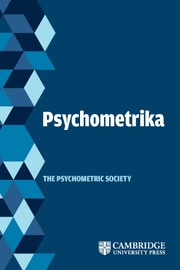Article contents
A Sequential Theory of Psychological Discrimination
Published online by Cambridge University Press: 01 January 2025
Abstract
A theory of discrimination which assumes that subjects compare psychological values evoked by a stimulus to a subjective referent is proposed. Momentary differences between psychological values for the stimulus and the referent are accumulated over time until one or the other of two response thresholds is first exceeded. The theory is analyzed as a random walk bounded between two absorbing barriers. A general solution to response conditioned expected response times is computed and the important role played by the moment generating function (mgf) for increments to the random walk is examined. From considerations of the mgf it is shown that unlike other random walk models [Stone, 1960; Laming, 1968] the present theory does not imply that response conditioned mean correct and error times must be equal. For two fixed stimuli and a fixed referent it is shown that by controlling values of response thresholds, subjects can produce Receiver Operating Characteristics similar or identical to those predicted by Signal Detection Theory, High Threshold Theory, or Low Threshold Theory.
- Type
- Original Paper
- Information
- Copyright
- Copyright © 1975 Psychometric Society
Footnotes
Support for this project was provided by the National Research Council of the Government of Canada. The second author was supported by an award under the Commonwealth Scholarship and Fellowship Plan.
I am indebted to Professors J. T. Townsend and E. A. C. Thomas for many stimulating discussions concerning the theory proposed here.
References
- 302
- Cited by


